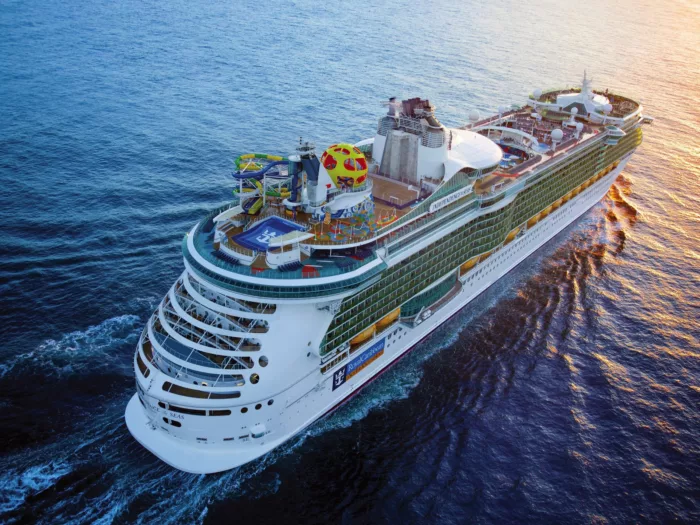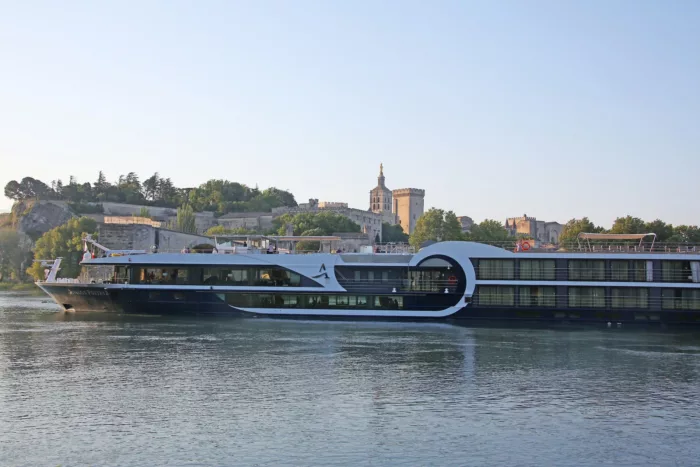
Cruise lines are absolutely catering for the visually impaired and blind
Cruises are popular among those with sight loss or visual impairment and for a multitude of good reasons. Safe, enjoyable, luxurious and open to feedback on accessibility, cruising is a haven for those with low vision
Taking a relaxing holiday can be surprisingly challenging for the blind and those affected by impaired vision.
While a holiday package or given location may offer an abundance of pleasant attributes, being unable to see the surrounding environment makes most activities difficult. Unfortunately, this can include activities that are usually intended to be fun. Consequently, this can derail hopes of relaxation in those with lesser sight while they are on holiday.
While those who are blind or visually impaired possess many tools and techniques that facilitate impressive functioning and navigation in the day-to-day environment, being in a novel place – such as a new town or hotel room – amplifies existent problems simply because the familiarity of learned environments has gone.
Problematic or not, the desire to travel and go on holiday remains just as strong among those with low vision as everyone else and in recent years, a trend has emerged to do so via cruise.

Where a blind or visually impaired individual may wish to explore multiple locations, activities and venues in one holiday, a cruise has the potential to provide both an intriguing and relaxing solution.
With the exception of shore tours, the main reason why a cruise may strongly appeal to a traveller with sight issues is thanks to the main amenities required during a holiday - accommodation, catering, entertainment – all residing within a singular environment that is the cruise ship itself.
Additionally, booking a cruise foregoes the need to have suitable hotels booked across multiple locations and skips the need to research how accessible each catering or entertainment venue will be throughout a holiday.
Better still, the layout of a cruise ship can be quickly learned with no need to worry about acquiring accessibility-friendly transport while switching from one activity to another.
Amid rising societal awareness of the accessibility issues those with disabilities face in tandem with awareness that their fleets hold huge potential for opening up travel opportunities to all, cruise lines are proudly making improved accessibility one of their key priorities.
Consequently, within cruise, those with sight loss or visual impairment are now well catered for. In their 2022 Passenger Accessibility Survey, DfT and MCA Maritime found that, among those with accessibility needs, the fewest issues were reported by those with either blindness or partial sight.

The rapid evolution of accessibility provision within cruise
Let it be known that cruise lines are more than open to feedback, particularly when it comes to accessibility provision.
Where a cruise line don’t get it right at first, exists a keen desire to learn from those who know exactly where remaining problems lie. You only need to ask Virgin Voyages who have consulted with former paralympic swimmer Donovan Tildesley on how best to assist passengers with low vision.
This unusual advisory role arose after Tildesley – who had starred as Canada’s flag-bearer at the 2008 Paralympics – was asked to disembark from Valiant Lady not long after he boarded the Virgin Voyages ship for a six-day Caribbean cruise. The line’s logic was they couldn’t adequately support him on board, particularly because he was a solo traveller.
Blind since birth, Tildesley reluctantly complied but voiced his frustrations on social media shortly after. This was promptly received by Virgin Voyages, who offered to fly him out via business class to the next port on the ship’s itinerary so he could rejoin the journey.
Tildesley agreed but only if the cruise line would accept his advice on accessibility provision for those with sight issues, which they agreed to. In a subsequent online post, Tildesley said: “It says a lot about a company when they can recover from a mistake.”
The following year, on the Virgin Voyages 50th anniversary VIP cruise, Tildesley met Virgin founder Sir Richard Branson before delivering a presentation on sight issues. A few months later, Tildesley trained Virgin Voyages crew on assisting blind passengers while the cruise line themselves set an example on how to be open to what is needed.
As this example shows, if considering a cruise as a blind or visually impaired passenger, remember that cruise lines are willing to accommodate you and learn from what you can tell them.
When choosing cruise, what is fundamental is going onboard with a good attitude and the expectation that someone will inevitably forget what it is like to not to see. Aim to enjoy the learning curve that is a fully sighted crew trying to assist you as best as they can. A two-way dialogue can prove a win-win for both sides.

How cruise helps blind or visually impaired passengers
A variety of provisions are available upon cruise ships to ensure blind or visually impaired passengers can retain a considerable degree of independence during their time aboard as well as having a good time.
There are several ways by which this is achieved, including:
1. Cruise staff anticipate passenger needs, particularly those with mobility or audiovisual issues
A significant component of what makes cruising special is rarely having to ask for what you want or need. Cruise staff are renowned for their ability to remedy an issue before it even becomes known and anticipate your needs almost as readily as someone who knows you better.
As the cruise industry diligently works towards credible accessibility provision, crews have been trained to be particularly vigilant when it comes to the requirements of passengers with mobility or audiovisual issues. Therefore, if you require directions while moving around the ship or assistance within a restaurant setting, don’t be afraid to ask.
Upon boarding, it is an excellent idea (and usually compulsory) to take an orientation tour. This is most likely to have been organised for you when you booked but if not, ensure to ask for this service to ensure maximum safety.
During an orientation tour, the crew will guide you around the main areas of the ship as well as ensuring you can safely navigate to your muster point from your cabin and other key areas.
Because of the sheer variety of room entry systems, we recommend asking someone to explain how to both enter and leave your cabin. In turn, this provides an excellent opportunity to ask how various controls around your room work so that you can have quick and full use of all your cabin’s facilities.
Throughout your cruise, remember that the crew are eager to assist. This can include having your waiter read your menu out loud or receiving directions for your muster point from a staff member.
Many cruise lines have qualified readers on board, specifically trained to read aloud to low vision individuals. Not only can a qualified reader enunciate complex text on your behalf but they can also verbally describe graphs, maps, pictures and diagrams.
For those with visual impairment rather than total sight loss, it is worth bearing in mind that the crew will generally spot a blind individual far more quickly than yourself. While visual impairment is a significant hinderance, it can also be classed as a non-visible disability so be prepared to ask for assistance a little more than your blind counterparts.
Finally, whether blind or partially sighted, ensure to ask for assistance during buffets whenever you can. Buffets are tricky to navigate as well as often being busy with other passengers and not usually labelled with braille.
Misplaced serving spoons can quickly prove tiresome and hot plates, sauces and steam escaping from chafing dishes all combine to make a potentially scalding obstacle. If you’re unsure in any way at a buffet, ask for assistance.

2. Braille signage
To assist with independent navigation, braille signage is located at various places around your cruise ship. These are usually found by doorways, next to entrances to bathrooms and alongside as well as inside elevators.
While many lines have braille upon their elevator buttons as well as an audio announcement of what floor you’ve arrived on, you usually need to establish what specific floor you need on your own. This will be most notable when you first begin your cruise, easing gradually as you learn your way around.
To help bypass potential frustration in the early days of a cruise, it can be helpful to have some notes on your mobile phone in case you forget what is located where. This is also invaluable when using the stairwells as floor finishings within a ship tend to be somewhat similar. Tactile signs elsewhere are also limited in the information they can provide. Having some prepped notes upon your person helps a great deal in counteracting initial issues with navigation.
If all else fails, simply ask a member of staff for guidance and you’ll soon be back on your way.

3. Guide dogs onboard
If you can’t imagine travel without your guide dog, take heart in that all of the mainstream cruise lines permit service/working dogs aboard their ships.
To board with a guide, you must be able to provide all of the documentation that your chosen cruise line requires. This will likely include your guide’s vaccination records and an up-to-date health certificate. You may also need licensing information and the capacity to prove your dog has been specifically trained for meeting disability-related need.
What specific paperwork will be required is prone to change so ensure to liaise with your cruise provider long before boarding in-order to simplify embarkation as much as possible. Be sure to ask what will be required at each of the different ports of call listed on your cruise ship’s itinerary as rules and regulations tend to differ from country to country.
While usually fully welcome on board your cruise ship, you may well encounter not being able to disembark with your animal at ports of call so take time to consider what you will do in these circumstances prior to them occurring.

Throughout the cruise, bear your guide’s comfort in mind in addition to your own. Although many dogs enjoy new challenges, many owners find that more than a few days at sea can begin to test an animal’s tolerance. It is therefore wise to reserve extensive cruises for when you are travelling without your guide.
Additionally, while using the elevator is convenient, a guide dog will soon begin to miss their opportunities for walks that they would usually enjoy elsewhere. Therefore, if you can manage, aim to use the stairs as often as you can to allow your companion to stretch their legs as you do so.
Another factor to consider is whether your guide will be happy being left alone in your cabin while you enjoy a meal or take in an evening’s entertainment. If they are, remember not to be away for too long and where possible, check-in periodically to ensure all is well in your room.
Ensure to pack a few items that will make the journey a little more comfortable for you and your guide. A spare harness can be a good back-up as can a few waste bags, cards that explain ADA access rules for guide dogs and extra pet food on top of what you would usually expect to be consumed during the time you are on your cruise.
Finally, bring a cane with you too. This allows for the possibility of your guide being unwell or for the times you wish for your guide to reside in your cabin. A cane helps retain the option of independent exploration of the ship.

4. Large print and audio materials
If you require them, it is usually possible to request a menu or schedule in large print. Equally, within the library, you are likely to be able to access large-print books as well as a selection of audio books. It can also be helpful to download a few audio resources in advance for enjoyment upon your cruise.
5. Accessible excursions
Many shore excursions are open to those with accessibility issues but be prepared for some being primarily orientated towards catering for mobility difficulties rather than sensory impairment.
Your cruise line will be happy to advise on which shore excursions are available while online research can yield fantastic providers of on shore accessible tours. To avoid disappointment, it is often helpful to call ahead to establish if excursion companies offer a more accessible approach and whether they are best placed to assist you as you require.
























